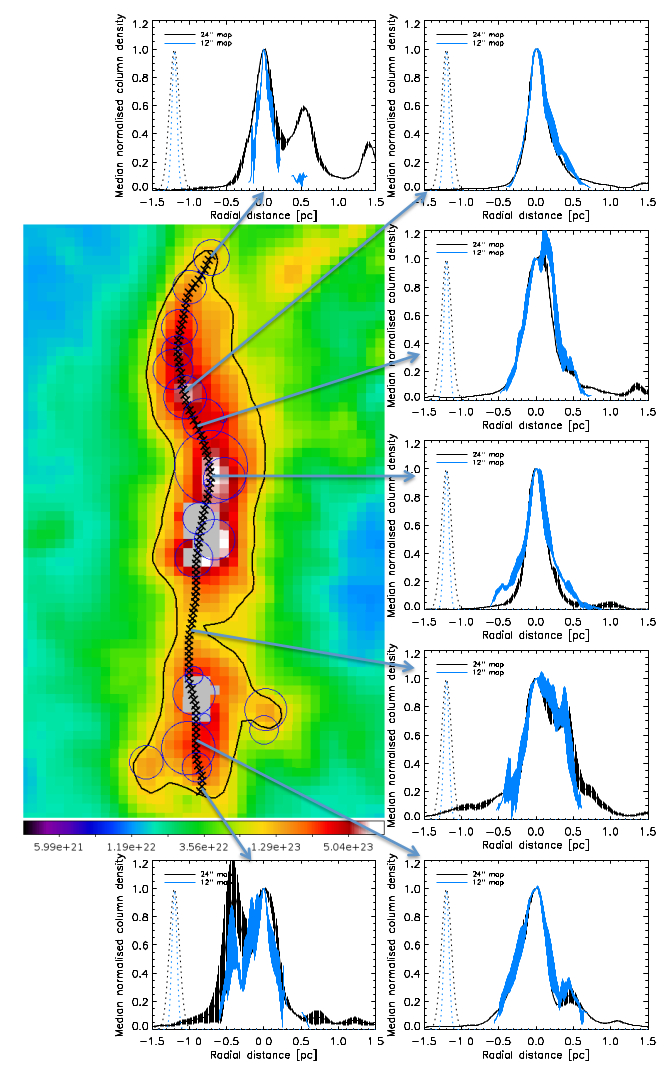
|
EPoS |
|
EPoS Contribution
|
|
Cloud structure and (high-mass) star formation rate: HOBYS Herschel observations of massive ridges, their feeding subfilaments, and the evolution of massive dense cores
Martin Hennemann AIM Paris-Saclay, Service d'Astrophysique, CEA Saclay, Saclay, France | |
| Herschel 100pc-scale observations of closeby massive star-forming regions as obtained by HOBYS, the Herschel imaging survey of OB Young Stellar objects (Motte, Zavagno, Bontemps et al. 2010), now provide an unbiased view on the detailed cloud column density structure and its population of massive dense cores - excellent candidates for high-mass star precursors. We present evidence that structures like the DR21 ridge, the most massive cloud structure in Cygnus X with a column density above 10^23/cm^2 over 4pc^2, a total mass of 20000 Msun, hosting 9 massive dense cores that dominate its structure, could be formed by the merging of filaments or flows: Several “subfilaments” connected to it are resolved with Herschel, extending the previous velocity study (Schneider et al. 2010). We find that the subfilaments are gravitationally supercritical and form cores and protostars which may become low-mass members of the OB star cluster(s) in formation in the DR21 ridge. The pronounced North-South elongation of the DR21 ridge resembles individual filaments as found towards low-mass star-forming regions, but at positions not dominated by compact massive dense cores we find wider, substructured perpendicular profiles, consistent with the observed convergence of two filaments at the endings of the ridge. The present mass in the subfilaments is a factor of 10 lower than the ridge mass, so they merely represent remnant flows. They show decreasing dust temperature towards their connection with the ridge, maybe indicating the pile-up of material to high densities which cools down to a minimum of 14K seen towards the Northern part of the ridge. However, their link to the clumps around DR21 and DR21(OH) means that these flows could have been important to build-up massive clumps inside the ridge. Extrapolating, we would expect the assembly of massive clumps towards the Northern part of the DR21 ridge where the most massive subfilaments connect, in continuation of the evolutionary sequence of star-formation along the ridge from South to North. We also use the large coverages obtained by HOBYS including Cygnus X (7000 pc^2) and Rosette (2000 pc^2) to establish a complete sample of compact massive, cold, and dense cores in the region and constrain their luminosities, dust temperatures, and envelope masses. For core masses of 20 to 1000 Msun, we find typical dust temperatures of around 18K. These key parameters are used to construct an evolutionary diagram of massive protostellar objects, and we use a set of simple evolutionary tracks for classification. In particular we will discuss the low luminosity-to-mass ratio found for part of the sample which may relate to the fragmentation of the cores. The number of massive dense cores is compared to the total mass of the host structures to estimate star formation efficiencies, rates, and rate densities. The very active star-forming sites like the ridges IRDC G035.39-00.33 and DR21 show values comparable to starbursts, i.e. rather unusual in the Milky Way. Given that 1/4 of the massive dense cores in e.g. Cygnus X formed in the DR21 ridge, and several such very active sites are found in HOBYS fields, we will discuss the tight link of high-mass star formation and the star formation rate to ridge structures. | |
 | |
| Caption: NO | |
| Collaborators: F. Motte, AIM Paris-Saclay, France S. Bontemps, LAB Bordeaux, France N. Schneider, AIM Paris-Saclay, France T. Csengeri, MPIfR Bonn, Germany P. Didelon, AIM Paris-Saclay, France Q. Nguyen Luong, AIM Paris-Saclay, France T. Hill, AIM Paris-Saclay, France HOBYS consortium |
Key publication
|